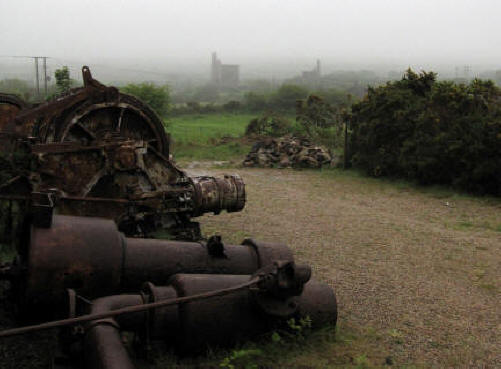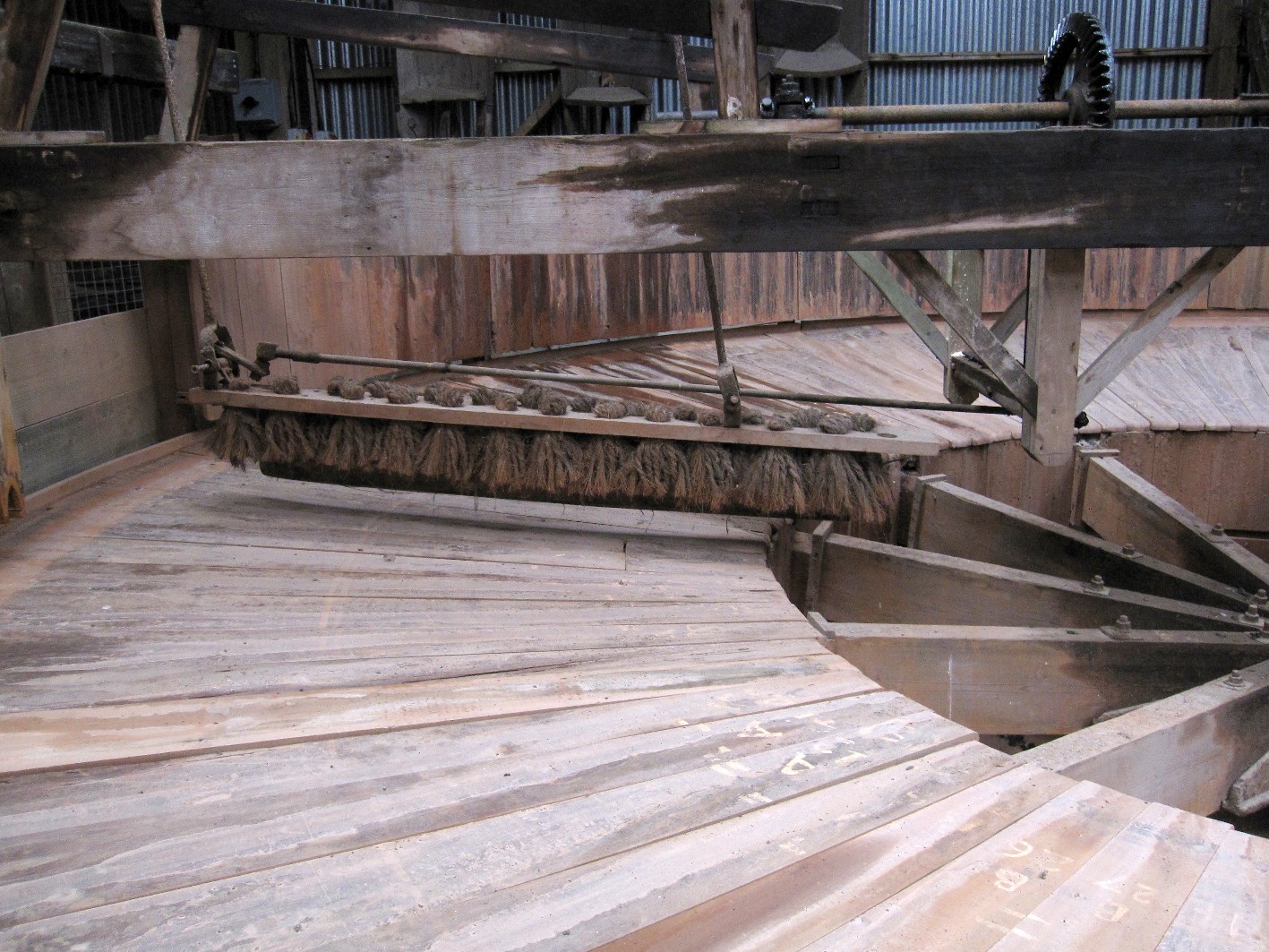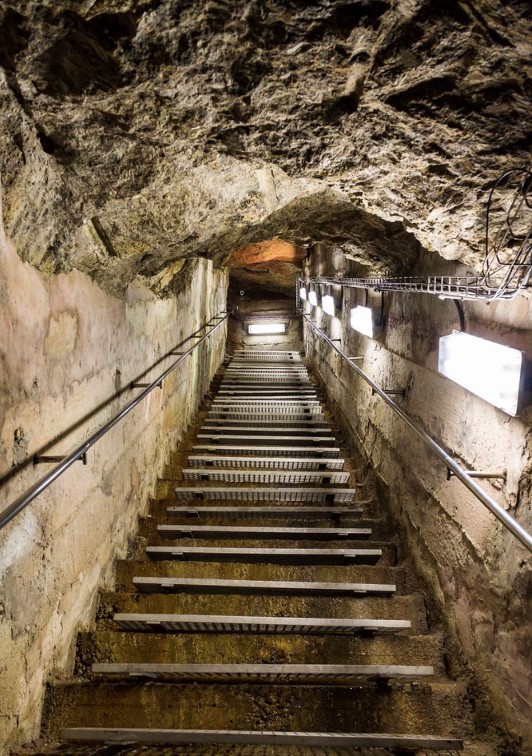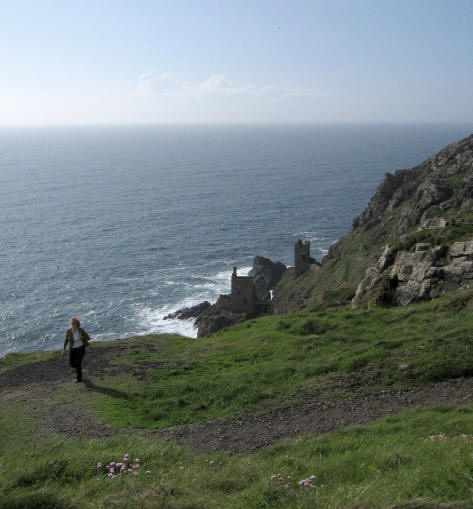|
   |
|
Page 5 |
Newsletter 115, Winter 2016 © Hampshire Mills Group |
Cornwall Study Trip - Part 2
Sheila
M Viner
Photos by Andy Fish and the
author
|
|
The third day of our trip started with a visit to
the King Edward Mine Museum. |
|
 |
In 2006 the UNESCO World Heritage Site Cornwall and
West Devon Mining Landscape was created, containing
old mining areas and their communities. The damp
and misty morning imbued the abandoned mine-littered
countryside with an ethereal, romantic atmosphere.
The original Camborne School of Mines was in the
centre of Camborne, but moved in 1897 to the
abandoned eastern part of the South Condurrow Mine a
mile or so away. It was renamed King Edward in 1901
and all of the buildings from that period have
survived to this day. In fact King Edward Mine, now
more than 100 years old, is the oldest complete mine
site in Cornwall. |
|
Museum Director Alan Renton explained how the King
Edward Mine had now become a museum as the actual
School of Mines moved to the new university campus
at Tremough, just outside Penrhyn, in 2005. Alan
explained how this mine had played such an important
role in educating miners, giving them hands-on
experience. We had seen some of the machinery at
Blue Hills Tin Streaming Mine which had been our
first mining visit: stamps, vanners, dipper wheels,
buddles. These, we learned, were superseded by
hydro-sizers, pumps and central electric controls.
Advice from a former tin dresser, Willie Uren,
helped the museum staff know about the tin mining
processes.
Today Camborne School of Mines is considered as one
of the best known mining colleges in the world and
students come from all parts of the globe. In 2012
the 34th International Mining Games was held at King
Edward Mine; teams were from Australia, Germany,
Netherlands, USA, and UK.
Alan gave a good overview of the mine and school and
our guided walk around the machinery married with
the well-presented exhibits. One of the volunteers
we chatted to was John Beale, who had spent some of
his youth in the 1940s as a Bevin Boy.
|
|

|
The Big Dipper, an enormous 15ft iron wheel was
silent and still. Trembling flat tables bearing
streams of water jiggled the ore into assorted ducts
and on a “buddle” or round table, a circulating
heather brush swept the ore down grooved channels
(pictured left).
Progressing from the mine to the mill, which is
where the tin ore was processed more recently, we
saw a great deal of rare equipment which would have
been in daily use in the early 1900s. They are
thought to be amongst the last examples of their
kind anywhere in the world.
|
|
The museum exhibits and displays covered every item
of mining life from the style of clothes, helmets
with candleholders, carbide lamps, hard fibre
helmets, electric lamps, to hard plastic helmets.
Other photographs showed us a mine manager, William
Thomas and his daughters, Christiana and Olive, who
worked at King Edward Mine. We read of the
dangerous working conditions and learned of a
dreadful disaster in 1906, when at the Marriott
Shaft, a roof collapsed at 200 fathoms plunging a
cage carrying the mine manager and 2 surveyors to
their deaths.
Reluctantly we left our absorbing time at King
Edward Mine to speed coastward for the Porthcurno
Telegraph Museum, and lunch. The sun shone on us at
“The Nerve Centre of the Empire” as the Porthcurno
Telegraph Museum has been called, because submarine
cables from here connected this hub to the rest of
the world.
Isambard Kingdom Brunel's SS Great Eastern was
employed for this pioneering work as a transatlantic
cable laying ship because its size made it the first
choice to lay the original cables that linked the
administrative and military outposts of the British
Empire. By the time the system was completed,
Britain's government had a method of effective
communication with its civil servants and military
commanders throughout the world.
Many problems were experienced with the first cables
as the too small diameter created too great a
resistance to the voltage used making the signal too
weak to be reliable. Attempts to increase the
voltage resulted in insulation breakdown and
subsequent failure of the telegraph link. These
days, heavily armoured cables across the shoreline
ensure against damage and a lighter construction
technique is used at depth on the ocean floor.
Cables are now usually fibre optic and therefore
much lighter in construction.
At the outbreak of World War 2 existing surface
installations were thought to be far too vulnerable
to attack and so in 1941 miners were employed to cut
tunnels into the solid granite of the valley's
hillside to house the telegraphy equipment.
Certainly an unforgettable experience for several
HMG members was a tour which Andy Fish describes:
|
|

|
“Alison, Ros, Peter, and Andy ventured up 'The
Escape Stairs', all 120 steps up a steep tunnel cut
through the bedrock. Headroom is slightly restricted
in places and it is necessary to wear a hard hat;
it was still quite a painful experience when you
banged into the low roof though! The stairs were
built at the same time as the tunnels that contain
the heart of the relay station and were to allow
safe evacuation in the event of an attack. They now
form a part of the visitor experience, leading to a
viewing platform overlooking the whole site area and
out to sea.”
There are many
telegraph related displayshoused in the tunnels
within the museum which was actually started by
former employees of Cable & Wireless from the
company's Holborn headquarters in London. The
building remained a training college for the
communications industry until 1993.
One hundred years after it first began its
operations, the Porthcurno Telegraph facility closed
in 1970.
|
|
Our last visit of the day was to another part of the
part of the UNESCO-listed mining area, Botallack, in
the parish of St Just. Romantic, picturesque views
are all around; derelict stone buildings that once
housed the busy mining enterprises stand forlorn
with engine houses perched on the craggy cliffs.
The earliest known records for mining activity in
this part of the St Just region date back to the
1500s although it is said that some archaeological
evidence points to mining here during the Roman era
and even earlier, the Bronze Age.
During its recorded lifetime this submarine mine
with tunnels extending far out under the sea
produced around 14,500 tonnes of tin, 20,000 tons of
copper, and 1500 tons of arsenic. It is estimated
that 1.5 million tonnes of waste would have been dug
up along with the minerals.
|
|

Botallack calciner and arsenic works
|
|

|
The renowned Crowns engine houses (pictured left)
which cling to the steep cliffs along with the more
inland counting house and arsenic works are all in
the care of the National Trust.
An enjoyable afternoon’s ramble along the South West
Coast Path to the Levant Mine (visited the previous
day) can be had following the ‘High Bal Walk’
footpath guide.
In 1865 the Prince and Princess of Wales visited
Botallack and descended a new diagonal shaft and
in so doing created a small boom in tourism that
caused the mine operators to charge visitors one
guinea per person. 30 years later the mine closed
as a result of falling tin and copper prices but in
the 1970s the area found fame again when it was used
for filming the first Poldark series: Manor Farm,
Botallack, was used as Nampara in both that and the
BBC’s new version of Poldark.
|
|
We had had another action packed day of assorted
visits, giving rise to much discussion over the
evening meal.
On the last day of the study trip, we visited Wheal
Martyn, Cornwall’s China Clay Museum. China Clay is
an important Cornish industry which is still going
strong. |
|
|
